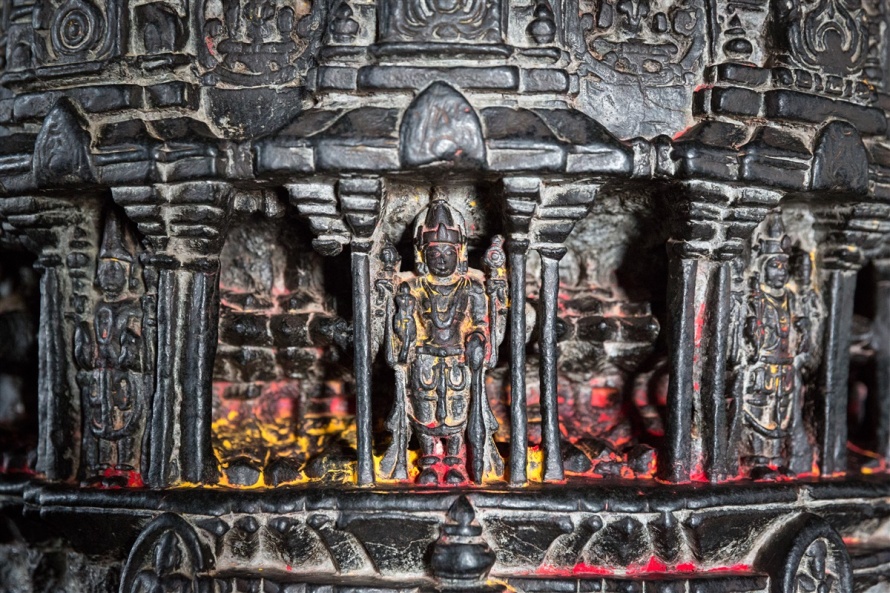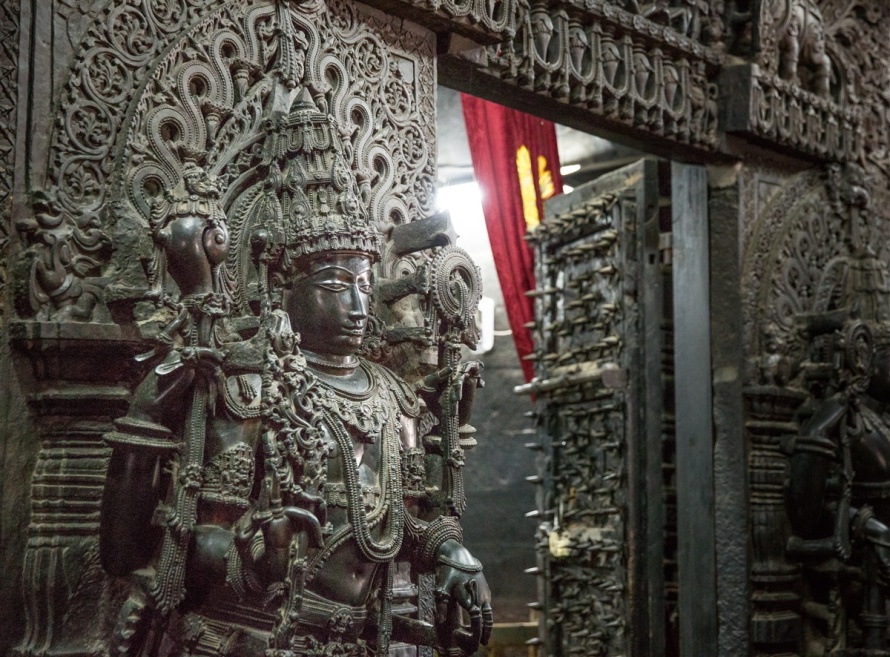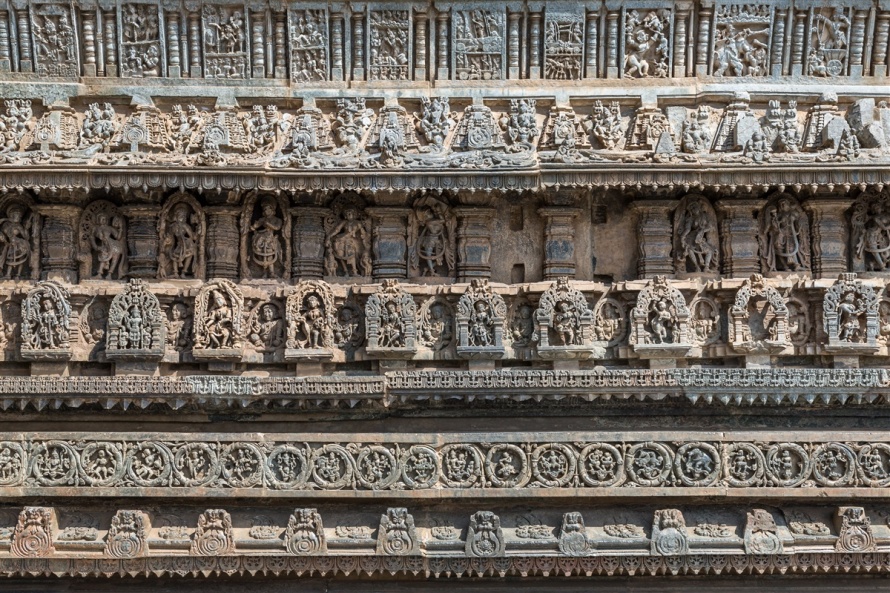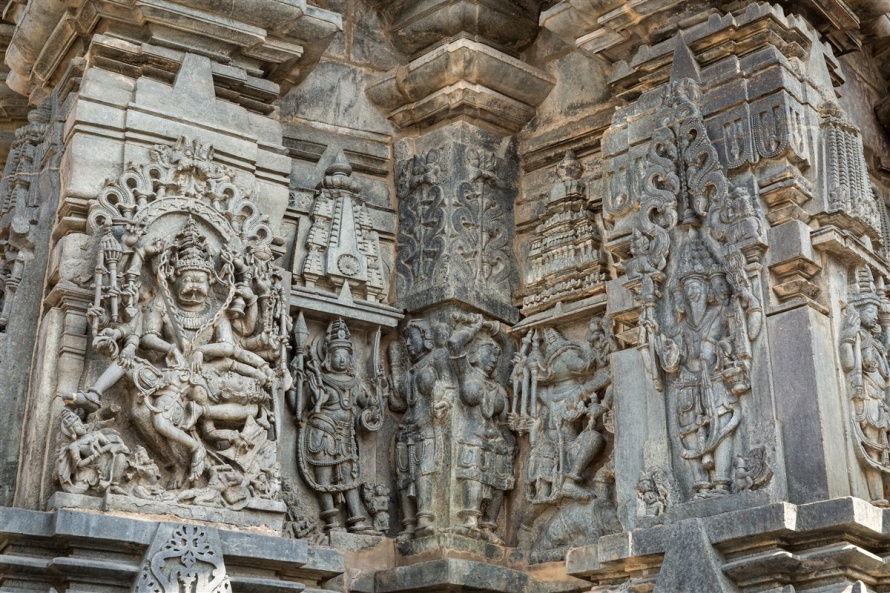
Belur, 39km north of Hassan, is celebrated for the Chennakeshava Temple, an outstanding example of both Hoysala art and architecture. Erected in 1117 A.D, it is believed to have been built as a victory monument by the Hoysala king, Vishnuvardhana.
The Chennakeshava Temple resides in a complex with other minor shrines and temples. The complex is entered through a 16th century Vijayanagara-styled gopura, which with its bright colour dominates the main street of the town.

The main temple, built entirely in grey-green schist (just as Halebidu is), consists of a sanctuary with minor shrines on three sides and a columned hall partly open as a porch in front.



The hall and sanctuary are raised on a terrace that repeats the complicated star-shaped plan of the building. The interior is dominated by polished multi-faceted and lathe-turned columns. All 48 pillars are unique and the many ceiling sections are incredibly well decorated.



The central supports have brackets with gracefully posed female attendants standing in ornate frames carved on the shafts.

The ceilings above have ornate domes with concentric corbelled rings, decorated with scrollwork and lotus buds.

Large guardian figures with richly jeweled costumes dominate the sanctuary doorway, with the doorway lintel showing Vishnu and Lakshmi seated within an arch.



The highlight of any visit to Belur and the Chennakeshava Temple has to be the madanikas, 38 in total surrounding the outside of the temple, between the eaves on the outer wall of the hall.



These depict Salabhanjika (or shilabalika – celestial damsels), the detail of which is simply stunning. They are presented in various forms, such as dancers, musicians and drummers, and are rarely erotic in nature. The pick of the group has to be the Darpana Sundari (lit,”beauty with mirror”), “The lady with the parrot”, “The huntress” and Bhasma mohini.


The other highlight of a visit to the temple has to be the doorways to the mantapa, here on both sides are images “Sala” slaying a lion.

Folklore tells a tale of a young man Sala, who saved Sudatta (his Jain guru) by striking dead a lion he encountered near the temple of the Goddess Vasantika at Angadi (now called Sosevuru). The word “strike” literally translates to “hoy” in old Kannada, hence the name “Hoy-sala”.

This legend first appeared in the Belur inscription of Vishnuvardhana (1117 A.D.), but owing to several inconsistencies in the Sala story it remains in the realm of folklore.

The legend may have come into existence or gained popularity after King Vishnuvardhana’s victory over the Cholas at Talakad as the Hoysala emblem depicts the fight between the mythical warrior Sala and a tiger, the tiger being the emblem of the Cholas.

At the base of the outer walls of the temple are friezes, depicting charging elephants (650 in total) which symbolize stability and strength, above which are lions which symbolize courage, and further up are horses which symbolize speed.




Above the horses are panels with floral designs signifying beauty, above which are sculptures with depictions from the Hindu epics, the Ramayana and the Mahabharata. These are very similar to the friezes that can also be seen at Halebidu.





The Hoysala artists, unlike other medieval artists, preferred to sign their work in the form of inscriptions. In doing so, they sometimes revealed details about themselves, their families, guilds and place of origin. Stone and copper plate inscriptions provide more information about them.





Ruvari Mallitamma was a prolific artist to whom more than 40 sculptures are attributed. Dasoja and his son Chavana who were from Balligavi in modern Shimoga district also made important contributions.




Chavana is credited with the work on five madanikas and Dasoja accomplished four of them. Malliyanna and Nagoja created birds and animals in their sculptures, and artists such as Chikkahampa and Malloja are credited with some of the sculptures in the mantapa.


In all 118 inscriptions have been recovered from the temple complex, covering the period from 1117 AD to the 18th century, giving historians details of the artists employed, grants made to the temple and renovations committed during later times.
In addition to the Chennakeshava Temple, there are numerous smaller shrines and temples that are well worth taking time out to explore a little further.
Also, if time permits, be sure to take a look at the covered perimeter wall of the temple complex. Here there are some interesting carvings that go largely unnoticed by the constant stream of visitors, and it’s a bit of safe haven from what can be at times quite a crowded place to visit.




The temple complexes at both Belur and Halebid can easily be visited in a single (long) day, and there’s enough variety to warrant a visit to both of them. The quality of the sculptures and carvings I don’t think can be surpassed in India, or indeed anywhere else on the planet, you really don’t want to miss out on seeing any of it !

You’re welcome to ‘Like’ or add a comment if you enjoyed this blog post. If you’d like to be notified of any new content, why not sign up by clicking the ‘Follow’ button.
If you’re interested in using any of my photography or articles please get in touch. I’m also available for any freelance work worldwide, my duffel bag is always packed ready to go…
KevinStandage1@googlemail.com















great post,wonderful detailed pics. glad you noticed the Star, a symbol usually seen in temples dated prior to 1200 A.D.
LikeLiked by 2 people
Very good collection, keep it up sir.
LikeLiked by 2 people
Thanks for stopping by Mahesh !
LikeLike
FANTASTIC
LikeLiked by 1 person
Thank you ! 🙏
LikeLike
Excellent as usual. I am yet to come across a more detailed and enjoyable blog on indian art and architecture. My pranaam to you.
There are a few other beautiful temples with amazing architecture near belur / halebid, including a small beautiful step well / tank. Have you been there by any chance?
LikeLiked by 1 person
Govindan,can you pls share the details of other beautiful temples including the step we’ll.
Thanks
Kumar
LikeLiked by 1 person